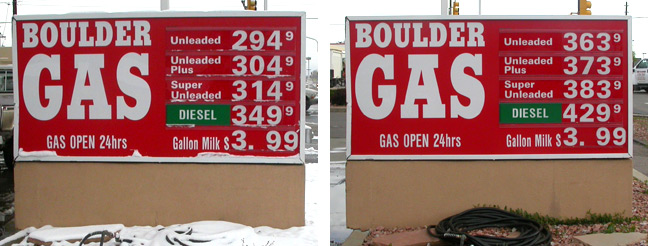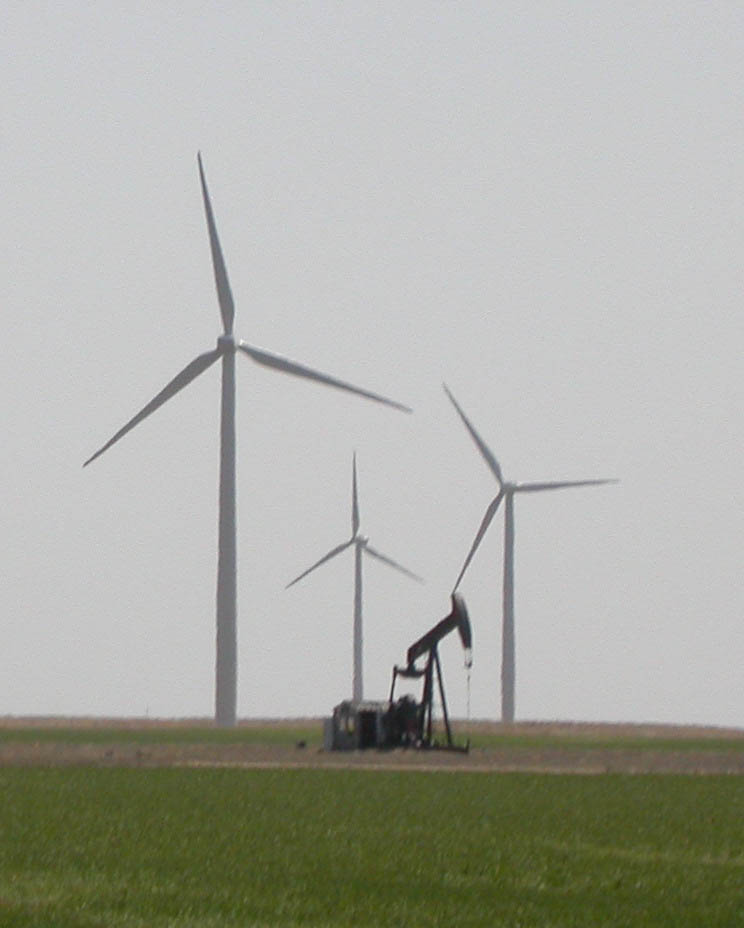The cost of using fossil fuels has gone up – we paid over $4.00 a gallon for gasoline for the first time this weekend. But of course there is the no-longer-hidden cost of what the carbon dioxide and other greenhouse gases released to the air when the fuel is burned do to our climate.

Figure 1. Watching the gas prices get higher than the milk prices. (Left) 5 March 2008; (Right) 15 May 2008. The four-dollar gasoline was purchased in Nebraska.
People are starting to respond sensibly, if slowly, by developing more efficient ways to extract power from fossil fuels or other sources in our environment. There is talk of cleaner coal and gas power plants, and making hydropower more efficient. Nuclear power is being considered more seriously. And we are developing new ways to get the energy we need. Among these are biofuels (for transportation), solar power, power from tides, geothermal, and wind power.
This weekend, I had the opportunity to drive through a large wind farm in northeastern Colorado, whose location you can find from the maps below.

Figure 2. (Left) location of Colorado. (Right) Location of Peetz.
The “wind farm,” near Peetz, Colorado, can generate up to 400 megawatts of energy. This makes the Peetz wind farm the second largest in the United States at this time. 400 megawatts is sufficient to power 120,000 homes in the U.S. There are 267 wind turbines, which cover an area that stretches for miles. It was fun to find out that oil is being pumped from the same land (Figure 3). Germany produces the most wind energy on Earth, with the U.S. second. According to the Global Wind Energy Council, wind power grew an average of 28% per year in the decade ending in 2006.
Theoretically, wind can be used to meet much of the world’s energy needs. But what of the negative side?
Many are worried about wind turbines killing birds. Current estimates of bird deaths from turbines run into the tens of thousands (U.S. statistics). To put this into perspective, many more birds are killed by collisions with automobiles, transmission towers, power lines, and windows. Such statistics aside, the danger to breeding populations, particularly of bird species that are no longer abundant, needs to be understood and considered.
But there are additional concerns. How do wind turbines themselves affect the weather and climate? Believe it or not, people are actually thinking about this. Also, the wind doesn’t blow all the time, so either a method is needed to “store” the energy, or we would have to use energy from another source when the wind isn’t blowing. Also, some people think that wind turbines are ugly (though others think they are beautiful).
Would you want a wind farm in the countryside or sea shore near you?
One more thing to think about. While higher energy prices make it harder for us to pay our bills for electricity, heating, and gasoline; high prices for energy also mean that industry will be more willing to develop new ways of extracting energy. Or, industry may be more willing to invest in figuring out ways to make conventional sources of energy more efficient. And higher energy prices make us more interested in using energy more efficiently by taking simple steps like turning out lights when we are not in the room, wearing a sweater and keeping the inside temperature cooler in the winter, and walking or taking the bus instead of driving.

Figure 3. A new and growing source of power – wind turbines, surrounding an oil pump (“pump jack”), representing a more traditional source of power. Near Peetz, Colorado, U.S.A.
